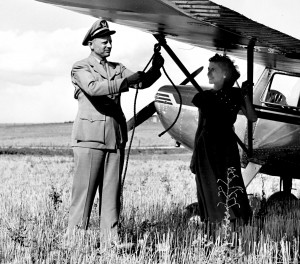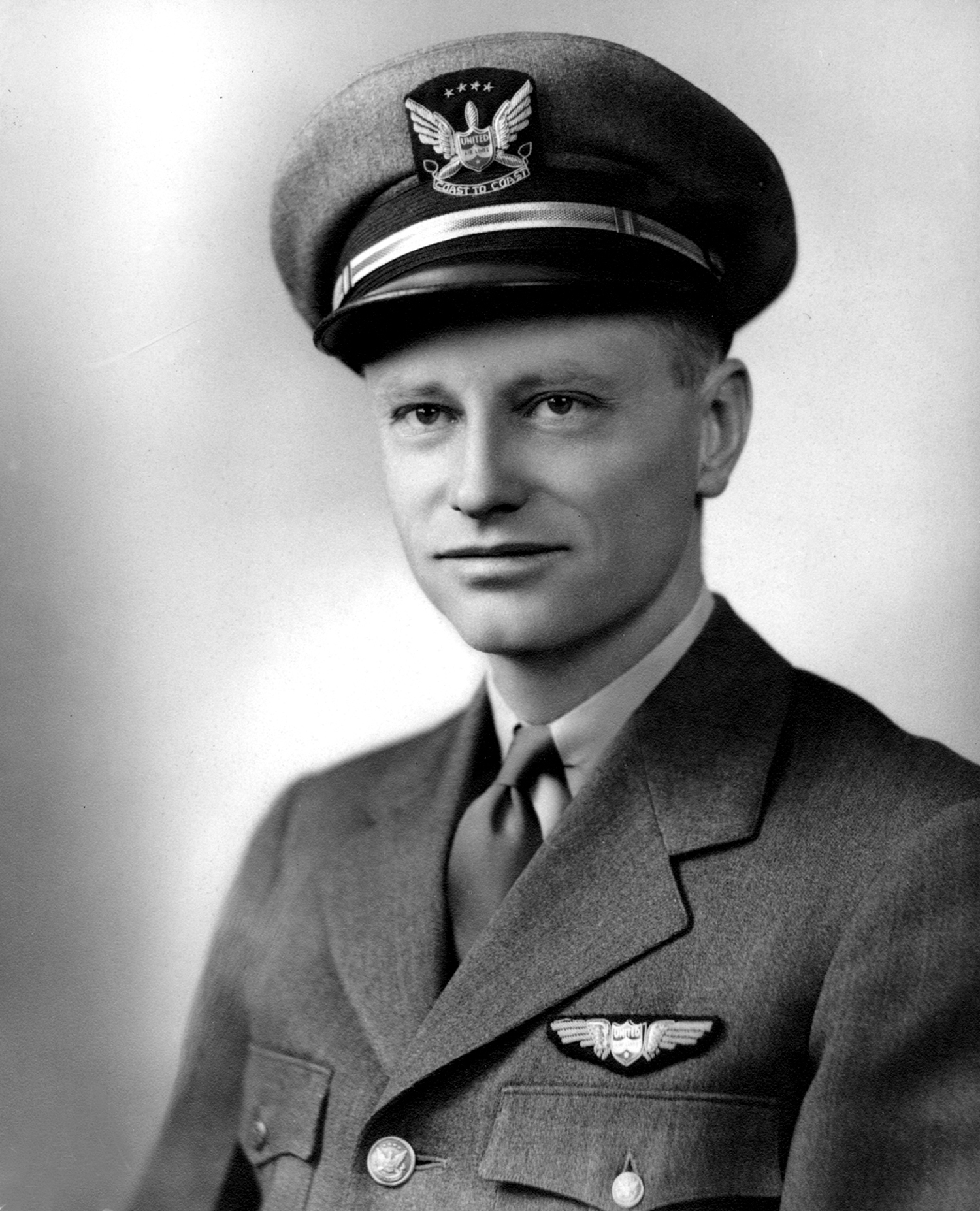By Deb Smith
Like so many pilots of Howard Reid’s vintage, his fascination with aviation began when an errant pilot landed a plane near the family farm in Roggen, Colo. He did what any curious kid in the early 1900s would do; he asked the dust-laden airman for a ride.

Fledgling United Airlines hired Howard Reid in 1940. He thought it would take him 18 years to make captain, but it only took him 18 months.
The pilot obliged. Reid’s first plane ride lasted mere minutes, but the sensation he felt would linger for nearly a century. As a matter of fact, he was still flying in February of this year-—at the age of 93. He died July 21, at his home in Roggen.
On the prairie, moving west
Howard William Reid was born to Bill and Sara Reid in the bedroom of a Denver aunt’s house on Aug. 4, 1911. Reid’s grandparents immigrated to the United States on separate ships from the Shetland Islands of Scotland. They met shortly after arrival, married, and settled in Sparta, Ill.
But Reid’s father, Bill, moved West. There had been a voracious malaria epidemic that swept through the Midwest in the 1870s, causing many to succumb, including his parents.
The Homestead Act was an interesting piece of legislation signed into law by Abraham Lincoln in 1862 shortly after the secession of southern states. The act literally turned over vast amounts of the public domain to private citizens. Nearly 270 million acres—-approximately 10 percent of the country-—were claimed and settled under this act.
Bill Reid was interested in getting a piece of the West for himself, so he made his way toward the Rockies. Becoming a homesteader seemed simple enough. One had only to be the head of a household and at least 21 years of age to claim a 160-acre parcel of land. However, the catch was the homesteader had to promise to live on the land, build a home, make improvements and farm for five years before they were eligible to “prove up” and keep the “free” land.
So with a standard filing fee of $18-—and the obligation of many years of hard work—-the elder Reid and his family staked out their claim near Roggen, in 1906, by building a four-bedroom house smack in the middle of the intersection of four handsome 160-acre plots.
Howard Reid spent his youth on that very farm, climbing trees, frolicking through the tall grass. Although he was home schooled for most of his academic career, Colorado law at the time required him to be present for at least the third and eighth grade.
To do so, he had to commute nearly seven miles on horseback. As a youngster, his parents would actually tie him to the saddle to keep him from falling off.
Howard Reid detested the brutal winters out on the prairie, as the razor sharp cold made the ride to school seem even longer, often requiring extended “thaw outs” at both home and in the classroom. Needless to say, when mechanized travel came about, Reid embraced it with open arms, eventually becoming an excellent local mechanic.
As he grew older, he never lost his enthusiasm for flight; he was always looking skyward for another errant pilot, and always hoping for yet another ride.
An airplane in a box
The elder Reid was painfully aware that most of the time his son’s head was in the clouds. The problem was what to do about it. The answer came easy.
Reid’s first airplane, a “build-it-yourself” kit, arrived in a wooden crate delivered right to the farm; some assembly was required, of course.
“He would have been around 11 or 12 at that time,” explained Reid’s daughter, Janet Reid, of Littleton.
He was thrilled with the acquisition and quickly went to work assembling the plane, while his father built a chicken coop out of the crating. Reid now had a plane, but sadly, he didn’t know how to fly.
“But he was perfectly content to just taxi around the field,” Janet Reid said. “Dad would taxi to the end of the field and because he didn’t know how to steer the plane, he’d jump out, push the plane and turn it around by hand, crawl back in and taxi back.”
If the breeze caught the plane just right, he would find himself accidentally airborne. While Reid enjoyed puttering around in the grass, and the occasional thrill of being airborne, he knew there was more to this flying thing than what he had.
When he was old enough, he began formal flight training at a Curtiss-Wright flying school at Denver’s Union Airport, at 48th Street and Dahlia, in Denver. He trained in a classic Curtiss Fledgling with a six-cylinder Challenger radial engine under the tutelage of Ray Wilson. He soloed and received his license in 1928.
With his ticket finally in hand, Reid launched a career in barnstorming and aerial mapping. He even eventually earned his A&P rating.
During the 1930s, Reid worked at many jobs to make ends meet. He delivered propane and later worked for the City of Denver in the tower at Stapleton Airport. At one time he was charged with sweeping out the city hangar.
The commercial airline industry was in its infancy, but the promise it held was breathtaking. Cities around the country were building airports, at that time, more as a matter of civic pride. However, in retrospect, they were actually building the infrastructure for a future industry that would connect the world.
Reid wanted to be a part of that future so he enrolled at the Boeing School of Aeronautics at Oakland, Calif. He was a long way from the farm, and only had an eighth grade education, so school officials were skeptical that the little boy with big dreams would be able to graduate.
“They were banking on him to fail the pilot training program,” explained Janet Reid. “They thought he’d make a much better mechanic.”
But Reid, who was often considered a “walking encyclopedia with a photographic memory,” surprised them all and graduated as a pilot-—and in the top of his class.
Back home in Colorado, he was energized. It was the late 1930s and the tall boy from Roggen joined up with a fellow pilot, Wesley Lewis, and formed The Reid-Lewis flying service at Stapleton Airport.
Both men were hired by United Airlines in 1940.
Flying United
Reid started on the United line flying the Boeing 40B, and by retirement was fully rated on the Boeing 707, 720 and nearly everything in United’s inventory.
Being a bit of a pragmatist, he had anticipated it would take him more than 18 years to make captain. He was wrong. It actually took him less than 18 months.
While flying the Boeing 720, Reid set two speed records: Salt Lake City to Denver in 41 minutes, and Denver to New York in 2 hours and 36 minutes.
He also flew the very first airmail trip between Milwaukee and Des Moines.
“I think the one thing my dad liked best about flying was all the interesting people he got to meet,” explained Janet Reid. “Back in those days, there were no private jets, so everyone—-even the big politicians and celebrities—-all flew on the same plane.”
And because Reid was such a conversational fellow, making friends everywhere he went, he got to know many of Hollywood’s greatest, as they winged their way across the country aboard United. One of his favorite passengers was the legendary John Wayne.
“John loved planes and used to like to come sit in the cockpit with Dad,” his daughter said. “At the time, his movie, ‘The High and the Mighty,’ had just been released and everyone knew the movie’s familiar whistled theme.”
As Reid called the tower with the Duke in the cockpit, Wayne reached over and said, “Gimme that mic. Let me talk to the tower.”
Reid passed the mic and Wayne began to whistle.
“Well the tower operator just went crazy,” Janet Reid said.
“Is that John Wayne you have on board?” shrieked the operator.
Life indeed was grand.
But while Reid thought he just couldn’t fly any higher than he already was, he would soon find his heart had the ability to soar to altitudes far beyond the capabilities of any airframe he had flown. It was during one of his regularly scheduled trips into Omaha that he would meet the “love of his life,” Doris Triplett of Red Oak, Iowa.
Doris was a dispatcher for United who caught Reid’s attention. In an effort to see her on a somewhat regular basis, he would continually bid trips back to Omaha, until finally, in 1947, he convinced her it would be less of hassle if she would simply consent to be his bride.
She agreed and Reid brought her back to Denver. Soon after, they welcomed a son, John, and a daughter, Janet.

Three things made Howard Reid’s heart soar—his home in Roggen, Colo., flying, and his lovely bride, Doris.
While Reid never served in the military, he did his part for the troops by flying Military Airlift Command charters for the Department of Defense during WWII, Korea and Vietnam. As a matter of fact, his last flight was into DaNang, Peoples Republic of Vietnam in 1971.
Life after United just kept getting better
Reid left United that year after almost 32 years, and more than 34,000 hours (of which 1,854 were instrument). To commemorate the occasion, he did what any retiring pilot would; he bought a plane, a six-place Cessna 210.
“Interestingly enough, I think my father did a lot more after he retired,” said Janet Reid. “It’s amazing; he was retired longer than he was employed.”
The Reids spent many happy times among the tumbling mirth of the clouds. And his desire to remain a part of the aviation community grew. He joined the Colorado Flying Farmers and flew many humanitarian missions for people who would otherwise not be able to travel by air.
Up until early this year, Reid was an active flight instructor. The Air Line Pilots Association member was also a member of the Colorado Flying Farmers and Ranchers; he was past president of the organization and once named “Man of the Year.” He held membership in the Aircraft Owners and Pilots Association and the El Jebel Shrine Air Patrol, where he was a past president.
Howard Reid was inducted into the Colorado Aviation Hall of Fame in 1990. He received the Oklahoma State University Rawhide Award, and was even highlighted by the World Book Encyclopedia in an article on commercial aviation.
Reid also belonged to the OX-5 Aviation Pioneers, an association of aviators who helped mold the development of early aviation. All pioneer members must have flown or worked on aircraft powered by the OX-5 engine. He was also a member of the United Airline’s Flying Octogenarians, the Silver Wings, the Colorado Association of Wheat Growers, and the Quiet Birdmen, a fraternity of aviators founded in 1921.
Inquisitive and exacting in nature, Reid was always surrounded by friends and family, as well as perfect strangers. His uncanny method of “interviewing” almost always was disarming, and enabled him to turn almost anyone into a friend.
“He was loved by almost everyone—even my old boyfriends,” chuckled Janet Reid. “That’s pretty discerning when your old boyfriend keeps showing up at your house to see your dad and not you.”
In addition to Doris Reid, his wife of 58 years, and Janet Reid, Howard Reid is survived by his son, John Reid of Roggen, and four grandchildren. Reid was cremated and a private family service is scheduled for later this year.
“My father had asked that his ashes be scattered by his crop-duster over his private grass strip,” explained Janet Reid. “We’ll abide by that wish.”











